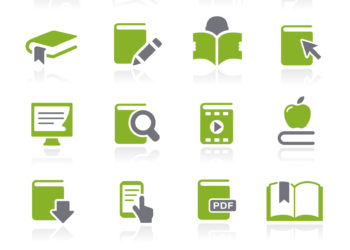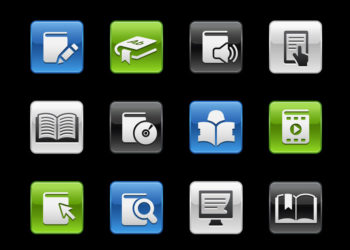Author’s Note: Recently I reconnected with an old buddy from grad school. He is now a retired professor of literature, with expertise in philosophy and literary theory. (Do not be concerned about me: I am fully vaccinated.) Our exchange has made me revisit this post from nearly a decade ago (2012), in which I argued that the way we think of digital media derives in part from a number of different, and often rivalrous, literary theories. The current fashion is to de-contextualize and de-historicize any utterance, as though we start each day with a clean slate, devoid of influences, especially nasty ones. This view of texts is itself part of a tradition, the implications of which we would do well to understand.
By this time, we know what an e-book is. It can be differentiated from the device we read it on, a device such as an e-reader, tablet, or smartphone, and in many cases it can be read on multiple devices. The e-book is not the device but the text that is displayed on the device. The text could be Boswell’s Life of Johnson or Stephen King’s 11/22/63, but it’s the same text, the same book however and wherever we read it. In fact, if you pour the text into an analogue container, a paperback book, for example, it’s still the same book. The Signet Classics edition of Crime and Punishment from my college days sits atop my (physical) bookshelves, in the very same translation that I read on my iPad.
Thus we know what an e-book is. It is pure digital spirit. It alights on one device or another and is conceived to be containerless. The container is the mortal coil, which the e-book shuffles off as circumstances require, to fly away to another device, another provisional container.
It is exhilarating to think of e-books in this way. You can almost feel the air beneath your wings as you stop reading on an iPad and then open up the same book — opened to the same page — on a mobile phone a few minutes later.

No wonder that the self-styled leaders of the movement to all-digital publishing think of this exhilaration as uniquely their own and sneer at those who cannot or will not take flight. To the digiterati, the spiritual nature of the e-book represents a keen insight into the nature of digital media. The digital spirit, the freedom from analogue containers — the victory of bits over atoms — is seen as a critique of the world of legacy print publishing. It is a theory of books: the book is a text, and the text has a life outside any particular manifestation. If you bring a librarian into the discussion, the conversation turns to preservation, the e-book equivalent of the hereafter.
It wasn’t always this way. There was a time before the book was deemed to be a text that can be uprooted from the circumstances of its creation. The book had an author, and knowing something about that author would help us better understand the book itself. Or the book arose from the historical circumstances of its original production. Or the book represented a psychosexual struggle with the demons of parents and siblings. Or the book was a loosely concealed set of political arguments, each fighting for hegemony. It was not preordained that all these rivalries would come to an end with the manifesto of the containerless e-book. That theory of the book, that it is simply a text, unanchored in personality or the circumstances of its production, has been around for decades; it is not an invention of Apple or Amazon. But it has been taken as the proper way to think about a book in the age of the e-book. The e-book, in other words, is a manifestation of one literary theory, though few if any practitioners of the art of e-book-making think of it as such. They simply are confident that they have the right idea, and anyone who does not share it is a “legacy” publisher or a Luddite, someone who is constitutionally incapable of perceiving the truth.
This view of the book — which, I should note, is as good as any other and perhaps in many instances, more useful — has an affinity for other positions about publishing. For example, we routinely hear about all the “knowledge” to be found in the collection of a large research library. But there is no knowledge in a library. There is information. It becomes knowledge when it is engaged by a human brain. Or some talk about “access to research.” But there is no research in the pages or screens of an STM journal. There is a highly structured description of research, but the research is to be found elsewhere, in laboratories and in the neural activity of the researchers themselves. The prevailing theory of the e-book has it that the meaning of the text lies in the text itself and not in the intellectual and imaginative spaces that that text points to.
It is this theory of the e-book that leads a corporation to digitize the collections of the world’s great libraries. This theory prompts us to contemplate text-mining and data-extraction. When we walk into the rare book room at a research library, we see quaint relics of a bygone era, not the living tissue of the circumstances of the book’s material incarnation. Erasmus, John Stuart Mill, Wittgenstein — these are all files, to be sifted and sorted, sent and stored, shared and saved.
We may doubt the existence of god, but on a day of brilliant sunlight and money in our pocket, His beneficence is everywhere evident.
It must be lonely for a book to be so digitally disembodied, and perhaps that is why the current theory of the e-book posits a context for the book’s consumption. It is as though having pulled the book up by the roots, with no connection to its origins or the physical attributes of the material world in which it was created, the new theorists want to plant the book again, as too much time outside the soil will cause even the heartiest flower to wither and die. Thus, the book has been injected into “the conversation.” The conversation is what you do every day online — it is what I am doing now. It consists of comments and critiques, tags and posts, the back-and-forth of blogs, GoodReads, Twitter, Facebook, and the open dialogues surrounding such prominent services as arXiv, SSRN, and PLOS. These new media tools and services throw out a lifeline to the deracinated book. The book becomes social, as much a member of the community as the people and robots that are its primary participants. The digital book becomes the imaginary friend seated at the table. We acknowledge it, we nod to it, and our lives proceed with this happy indulgence in our shared fiction.
The theory of the purely spiritual e-book was only one of many, but the circumstances of networked communications have pushed it out ahead of all others. The theory of the e-book was not necessarily “true” or “right” in any conventional sense of those terms, but the Internet and the world of mobile media have made it seem convincingly right in practice. We may doubt the existence of god, but on a day of brilliant sunlight and money in our pocket, His beneficence is everywhere evident. Thus the e-book: elusive as leptons and muons, but everywhere around us, providing a virtual anchor to our own deracinated lives.
Of course, it is only a metaphor, this book without an author, this containerless collection of words; and like all metaphors, it breaks down at some point. We are not there yet. The theory of the e-book still has a distance to ride, but when it comes to the end of the road, new metaphors will rise up. We will know that time has come when the e-book unfriends us on Facebook.
Discussion
2 Thoughts on "Revisiting: Theory of the E-book"



